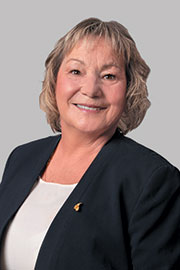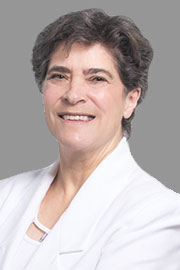- Sep/28/23 1:20:00 p.m.
- Re: Bill 131
I’d like to thank the member from Richmond Hill for her comments. Yesterday, I asked the Minister of Infrastructure about the broken promise that the Conservative government made prior to the 2022 election about the additional $160 million to improve the GO Transit service to London and area at the heart of southwestern Ontario, and I just wanted to reiterate for the member that that broken promise lets down so many rural communities in southwestern Ontario who need a regional transit model, not just the GTA.
I speak with many great farmers in the London area who can’t get workers into the good-paying jobs that are there waiting for them. Some businesses have even resorted to hiring their own bus to get people to work. Areas like Sarnia–Lambton, areas like Perth and many more can’t get the people there and they have to do it on their own because the government has let down rural Ontario.
My question: When will this government stop neglecting rural Ontario and invest in regional transit that meets the needs of southwestern Ontario and meets the needs of Ontario’s wonderful farmers and agri-foods industry?
- Hear!
- Rabble!
- Sep/28/23 1:20:00 p.m.
- Re: Bill 131
Thank you to the member from London North Centre. Thank you for that question. It is exactly because of that that we have this Transportation for the Future Act. We know that we are going to work together with municipalities, we’re working together with the regional transit system, and this is what this act is about. We are building on this and working towards that.
That’s why we ask for your support to get this bill passed, so that what you’re asking for is going to be fulfilled. This is exactly why this bill is being introduced.
- Hear!
- Rabble!
- Sep/28/23 1:30:00 p.m.
- Re: Bill 131
Thank you, member from Brampton West. Yes, this is part of the expansion we’re working towards. That’s why we’re working with the municipalities to build this special transit system to the Golden Horseshoe area. This is why we’re introducing this bill, in order to move things faster so that we can get the economy and get the project that we have planned for in the Golden Horseshoe area to come to reality. Thank you for your question.
That’s why we are doing this Transportation for the Future Act. That’s why we’re working with municipalities. They can come to us and work together with us with this collaboration. You will soon see; the same thing happening to me will be happening to you as well, and I’m looking forward for you to tell me the joy and excitement that you have shared, like what I’m sharing now.
That’s why I ask you to support this act. Let’s work together to build a better transit system across the province.
That is why we have this special—the transit-oriented communities—we are helping them to have the station contribution fee. We are working with them so that they can build the transit system that they need in their municipalities. We believe the municipalities themselves know what their needs are, and we will work closely with them.
If you have any good suggestions, please ask your municipalities to come up with a good plan so that we can work with them on what we call the SCF, the station contribution fee, so that we can work with them to have more homes built around the community and fulfill their needs as well.
That is why, in Richmond Hill, I understand there will be a lot more transit-oriented communities built around that area. I cannot wait to see the economy that it will bring to Richmond Hill.
- Hear!
- Rabble!
- Sep/28/23 1:30:00 p.m.
- Re: Bill 131
Speaker, through you to the member for Richmond Hill: For over a decade as a city councillor, now as St. Catharines’s MPP, I’ve been advocating for GO train service with the city and Team Niagara. While it’s a positive step that we recently secured a few additional trips, the hard-working commuters of St. Catharines are still awaiting all-day GO service from Niagara to Toronto. Why does this legislation prioritize new transit stations instead of ensuring and funding continuous services that already exist, like those in Niagara? When will we see all-day GO from Niagara to Toronto?
- Hear!
- Rabble!
- Sep/28/23 1:30:00 p.m.
- Re: Bill 131
Lanark–Frontenac–Kingston.
Thanks for the presentation, to the member from Richmond Hill. A follow-up to the question from the member from London North Centre: Could you describe for us the communities or type of communities that will benefit most from this bill?
- Hear!
- Rabble!
- Sep/28/23 1:30:00 p.m.
- Re: Bill 131
I want to thank the member for Richmond Hill for her comments. Would she agree that the times that we’re in, with the housing crisis that we have, have precipitated the urgency and the need for us to move forward with this legislation? Because the boundaries are seamless to a person who’s looking for a home. They need to find a home where they can, and they have to have access to transit that’s seamless, municipality to municipality. I wonder if the member could comment on that.
- Hear!
- Rabble!
- Sep/28/23 1:30:00 p.m.
- Re: Bill 131
There are provisions in the bill that suggest that the province is not planning on funding the building of all GO stations. Rather, they’re looking for already-strapped municipalities to come up with the money.
My question is, would there not be more than enough provincial dollars available to build GO stations without pressuring municipalities if the government reined in the gravy train currently being ridden by the 59 VPs of Metrolinx?
- Hear!
- Rabble!
- Sep/28/23 1:30:00 p.m.
- Re: Bill 131
Thank you to the member from Richmond Hill. Our government is taking action, Madam Speaker, to build Ontario by introducing this Transportation for the Future Act, 2023, which, if passed, would help build more GO Transit stations, support housing around transit and make it more affordable and convenient to travel across the greater Golden Horseshoe, helping families save money while increasing ridership.
My question to the member from Richmond Hill is, can the member explain to the House how the station contribution fee will accelerate transit expansion across the greater Golden Horseshoe?
- Hear!
- Rabble!
- Hear!
- Rabble!
- Sep/28/23 1:30:00 p.m.
- Re: Bill 131
As the disability critic for the official opposition, I am honoured to rise to debate Bill 131. Transit is very important to me. I moved to Hamilton at 18 years old for school about 11 years ago. To be honest, Hamilton was the first city I felt I could freely travel around without the risk of getting stuck or being harmed. The subway systems in Toronto at the time were, and are still, difficult to navigate if you’re someone with an assistive device. Wheel-Trans had at that time, and continues to have, consistent backlogs. These reflections, Madam Speaker, are from my experiences in Toronto over a decade ago, and not much has changed with regard to barriers facing disabled people across the GTA.
I remember being stuck in a TTC subway station as a teenager because an elevator was not working. I actually got off the subway, tried to get up out of the station, and I couldn’t go backward because there wasn’t a line that went the opposite way. So a security guard had to actually help me up the stairs—
- Hear!
- Rabble!
- Sep/28/23 1:40:00 p.m.
- Re: Bill 131
Just stop the clock for one moment, please.
Can you go ahead and help the member from Hamilton Centre so that she can read properly?
Interjection.
Is that okay? Can you see?
You can start the clock again, thank you.
- Hear!
- Rabble!
- Sep/28/23 1:40:00 p.m.
- Re: Bill 131
Thank you to the member from Hamilton Centre. Accessibility, of course, is very important to this government and, as you know, all new stations will have to meet the high accessibility standards that are currently in place. I’m wondering if the member could tell us if she feels that having more GO stations in closer proximity to where people live will assist with accessibility.
- Hear!
- Rabble!
- Sep/28/23 1:40:00 p.m.
- Re: Bill 131
I couldn’t get up out of the station because the elevator was broken, so a security guard actually had to lift my, at that time, 299-pound wheelchair up dozens of stairs and I had to slowly climb my way out of the station. To be honest, I’m still kind of nervous around taking the subway because it’s not accessible and it’s not as accessible as it should be.
The great thing about Hamilton’s HSR system is that it’s currently free for people with disabilities who use assistive devices, and every bus is fully accessible. And it’s because of this functioning system that I was able to travel around Hamilton for work and school and to actually live fully and independently—
As a former founding member of the Hamilton Transit Riders’ Union, and as someone who still commutes using our public transit system and GO Transit system to get to work as an MPP, I really value fully functioning transit systems and see this as a disability justice issue. Functioning transit systems for many disabled people across Ontario are liberatory, and that’s why we support efforts to broaden access to public transit and to improve service levels and the quality of public transit.
This is what the city of Toronto just accomplished under the leadership of Mayor Olivia Chow. The city of Toronto cancelled proposed cuts to TTC services, utilizing operating funds that were intended to operate the delayed Eglinton Crosstown project, and this will ensure TTC riders can count on prompt service.
As my colleague in Ottawa Centre highlighted in debate just yesterday, there are aspects to Bill 131 that do need work and this is what I intend to talk about today. Firstly, schedule 2 implies the existence of a new Transit-Oriented Communities Program, of which the details remain unknown. The original idea was for Metrolinx to negotiate deals in which developers would fund a new GO station in exchange for development rights. Now the government evidently expects municipalities to assume funding responsibilities. We don’t really have any idea based on what’s written here what sort of funding agreement the government has in mind, or how risks will be allocated. Municipalities may be required to assume risks related to cost overruns without having any control over procurement or delivery.
I believe transit ought to be publicly owned, operated and maintained. Adding developers into the mix and offloading responsibilities onto municipalities could make it harder to keep jobs local and to contribute back to our communities. My faith in these P3 deals, in Metrolinx and in the government as it relates to these transit projects has really been shaken. Hamiltonians have been waiting years for a hypothetical LRT project that has displaced many people from their homes along the LRT route, with no real, tangible plans in place to give back to the community for these losses. And I was someone who was very pro-LRT when this project was first proposed in Hamilton.
I met with Metrolinx in late August to ask about a constituent who had recently been evicted from his apartment unit along the proposed LRT route due to the build, and I was told by Metrolinx that he would be compensated for his loss, but there was no real plan or tangible outcomes in place. Meanwhile, we know that there are a handful of Metrolinx properties that are no longer on the proposed LRT route in Hamilton that could be put toward housing people right this minute.
Madam Speaker, I have also met with people living in encampments in Hamilton, living in tents, who did live along the proposed LRT route who now have nowhere else to go. Often, they were on fixed incomes such as ODSP and could not find new places to live on the current rates. This government and Metrolinx need to move with more care as they continuously tend to push through transit projects because I do not want to see more people displaced for a transit line that is epically failing, like the Eglinton Crosstown. People deserve more well-thought-out planning, and that includes people in Hamilton Centre.
Secondly, the government has also said, without much detail, that municipalities can only levy a station contribution fee on developers building housing projects and amenities at GO stations provided an incentive of some kind is offered. Given recent instances when this government has engaged the private sector in controversial or questionable infrastructure projects, this is concerning. They cannot keep offloading the responsibilities of what should be a public good or service onto developers. A transit station charge offers a more focused revenue tool in which developments most likely to benefit from a new station are responsible for more of the costs, as opposed to a development charge that applies to all developments across a municipality, including those that would not benefit much from the station.
Thirdly, I echo our transit critic’s ask that schedule 1 of Bill 131 must be repealed, as it is unnecessary. The Amalgamated Transit Union Local 113’s collective agreement already allows for transit service integration, provided reciprocity of service is assured with other transit agencies. An interest arbitration award confirmed this union rate. If the government opens up the TTC’s collective agreements from this House, transit workers will push back. And as the member from Ottawa Centre said yesterday, they are proud of their collective agreements and have worked for decades to ensure the quality of TTC service and well-being of TTC workers. An unconstitutional intrusion into their workplace will not be well received.
In Hamilton, the Keep Transit Public coalition, alongside ATU Local 107, are fighting for their right to maintain and operate Hamilton’s future LRT system, which could bring dozens of jobs to Hamilton. The Hamilton Community Benefits Network have also struggled to get real agreements from Metrolinx and the province on the ways the LRT system can cause the least amount of harm to workers locally. I echo the calls of the Keep Transit Public campaign to allow Hamilton’s LRT to be publicly maintained and operated.
There are serious concerns about this bill, including the potential interference with collective bargaining as well as a potential plan to download financial responsibility for provincial infrastructure onto municipalities. In the midst of issues with the Eglinton Crosstown and the Hamilton LRT, and in light of the ability for Metrolinx to commit to finishing projects that they start, we ought to move cautiously and ensure that this government does not continue to set itself up to fail in the realm of transit by clearly biting off more than it can handle. Like TTCriders, for reasons of accessibility, I also do support fare and service integration that would allow riders to travel seamlessly across transit agency boundaries without paying multiple fares or waiting for the right kinds of bus, but there has to be a fair agreement between the TTC and the union.
There is also a lot of other work that this government is neglecting around meeting its accessible transit deadlines for 2025. Creating accessible transit doesn’t always mean coming up with quick, new projects. We need to commit to making sure the transit systems that we currently have available are actually accessible, and I’ve received several calls specifically from people with visual impairments who find the current GO train system very difficult to navigate. I have also had many calls and have experienced myself how unreliable the West Harbour GO train times have been and continue to be.
I would urge this government to consult with disabled community members about what is and isn’t working and commit to creating an accessible Ontario by 2025, as promised, rather than continuing to start and fail multiple times at creating new transit systems and projects. We need to focus on a transit system that gives back to communities and stops these failed public-private partnerships.
Interjections.
- Hear!
- Rabble!
- Sep/28/23 1:50:00 p.m.
- Re: Bill 131
Again, we greatly appreciate the comments today from the member from Hamilton Centre. I do appreciate the member’s comments, especially the personal touch with regard to the member’s own use of the transit systems to get to this facility to do this amazing job.
I’m wondering if the member can speak to the idea that the people, especially the people who have accessibility challenges, in Bowmanville, in Durham region, across the larger region, shouldn’t have the similar advantages and the access to transit systems that the people in Hamilton have to be able to get to this centre.
- Hear!
- Rabble!
- Sep/28/23 1:50:00 p.m.
- Re: Bill 131
I’d like to thank my colleague the member for Hamilton Centre for her powerful and insightful remarks based on sharing her personal experiences as someone who uses a wheelchair and tries to use transit, which often fails her.
My question is around the government’s Transit-Oriented Communities Program, which has been very, very short on details. There is certainly a cloak of secrecy that surrounds that program. In light of that, does the member feel confident in the government’s ability to ensure a transit system that actually meets the needs of all Ontarians, including Ontarians with disabilities?
- Hear!
- Rabble!
- Sep/28/23 1:50:00 p.m.
- Re: Bill 131
It depends on if the station itself is accessible. There are also issues in the station that have created difficulties for people to navigate, including how things are labelled and just people’s ability to get around in the actual station.
So, yes, in some ways, having more stations could help with accessibility, but unless this government actually commits to building an accessible Ontario by 2025 and meeting its real targets, more of the same problem isn’t going to fix the underlying accessibility issues.
We really do need to fix the subway system, because it’s not clear where to enter for people in wheelchairs or walkers, or who struggle to get around, and when construction is added into that, it’s just really unsafe.
And then continuously saying these solutions are going to help people who are struggling with housing, when I’m seeing the opposite—these failed transit projects, over and over again, whether it’s the Eglinton Crosstown or the Hamilton LRT, are actually making people’s housing issues worse, in my opinion.
I think we need to go back to the table and think about how we’re going to make our current transit systems accessible, rather than continuing to introduce shiny new projects that often continue to fail.
I just don’t see a way forward that shows me that this government is prioritizing disabled people when we do talk about transit.
- Hear!
- Rabble!
- Sep/28/23 1:50:00 p.m.
- Re: Bill 131
Thank you to the member opposite. Madam Speaker, I heard the members opposite speak about investments in rural Ontario. There’s no government in the history of Ontario that has made more investments in rural Ontario. Not only are we investing $184 billion in infrastructure over the next 10 years, we’re making unprecedented investments in transit.
My question to the member opposite is, will the member opposite vote in favour of this bill and support the people of Ontario?
- Hear!
- Rabble!
- Sep/28/23 1:50:00 p.m.
- Re: Bill 131
Thank you, Speaker, and good afternoon.
Interjections.
It’s a pleasure to join the debate on Bill 131, the Transportation for the Future Act, 2023.
Speaker, when you step back and you read the bill—it’s not a long bill to read, as you know—there are some key aspects in it. One of the underpinning aspects is that it delivers on our plan to build a stronger Ontario, doesn’t it? It does. The proposed legislation, if passed, will improve transit service and convenience and help the province and municipalities like Whitby, Pickering, Ajax, Oshawa and eventually Bowmanville to build transit-oriented communities along the GO rail system, going east and west, allowing for more homes, affordable housing options, parkland, retail and office space near transit.
Speaker, the proposed legislation is a response to requests from the municipalities that I just referred to in the region of Durham and other upper-tier governments across the greater Toronto and Hamilton area for a new optional funding tool that will enable municipalities to raise revenues to build much-needed transit and housing. The new tool is called the station contribution fee. Speaker, it’s going to allow municipalities to fund and design the construction of new GO stations and recover the costs over time, as transit-oriented communities like Whitby, Oshawa, Clarington, Pickering and Ajax build around some of the future stations as we move further east, beyond Oshawa, going forward. What this will also do is help speed up the construction of new GO transit stations while also creating new opportunities for mixed-use communities around those stations.
That particular statement that I just made is a good segue into a statement that I received from the mayor of Clarington. You’ll remember that we’re going to go further east beyond Oshawa to Bowmanville. When the mayor read the news release related to Bill 131, he was prompted to provide this statement, in part from a news release that he posted on the Clarington website. Here’s what he had to say, Speaker:
“The planned extension of the province’s GO Transit network to Clarington will introduce significant economic and employment opportunities to the community. The faster the two stations planned for Clarington can be built, the quicker the GO train can come here, bringing better transit options for Clarington residents and a better quality of life. Regular GO Transit service has the potential to transform the Major Transit Station Areas ... in Bowmanville and Courtice. Clarington thanks the Ontario government for their determination to complete the GO Lakeshore East extension and strengthen the economic potential of Clarington and”—yes, Speaker, the region of Durham.
It’s not only Clarington that is pleased about the announcement on Bill 131. As you would expect, the region of Durham, which is the upper-tier government in Durham that’s comprised of eight municipalities—the announcement by the Honourable Kinga Surma about Bill 131 also initiated a response from the regional chair. This is what he had to say:
“This legislation brings Durham region one step closer to its vision of vibrant, livable and sustainable communities near new rapid transit stations. We applaud the province’s innovative approach to economic development, enabling new legislation to help make the four new stations along the GO Lakeshore East extension into Bowmanville a reality.”
That’s John Henry, the regional chair and chief executive officer for the region of Durham.
Speaker, the recent steps undertaken by the government—and this is an important step because it’s interrelated to the underlying principles of Bill 131—to extend GO Transit service to Bowmanville are a strong step forward in affecting this particular legislation, because every day, thousands of residents from east Durham can commute to work in or around the greater Toronto-Hamilton area.
Now, as communities continue to grow within the region of Durham, the need for more and better transportation options is clear. I see it every day commuting from Whitby into Queen’s Park. That’s why the Bowmanville GO extension will be a game-changer for residents along the Lakeshore East line, improving access to jobs, housing and local landmark destinations.
But, Speaker, there are many more benefits that I want to share with you and my colleagues here in the Legislative Assembly, and those are:
—moving people from their vehicles to public transit, thereby reducing congestion on the 401;
—enabling sustainable, walkable transit-oriented communities; and
—increasing the provision of housing, including affordable housing units.
Speaker, the extension of the Lakeshore GO Transit East is a signature project in the region’s post-pandemic recovery framework and action plan. I had the occasion last night to speak at the Ontario power corporation headquarters to an audience of about 325 people—entrepreneurs, but other representatives of the broader community across the region of Durham. Included in that group was the executive director of economic development for the region of Durham, and he was absolutely ecstatic that this particular legislation has been brought forward because it’s going to be the kick-start for the implementation of the recovery framework and action plan going forward.
Speaker, going forward, the extension will also support job growth, reduce traffic, connect students—and we’ve got two universities in the region of Durham: Ontario Tech, Trent Durham and, of course, Durham College, which is in my riding.
I want to take a moment, Speaker, at this juncture of my remarks—and I’m conscious of the remaining time that I have; it is 12 minutes, but there are some key points that I think are material in the discussion of this legislation and its relative impacts. I want to take a moment to explain how the proposed station contribution fee would work.
Key to me, Speaker, as a former member of the Durham regional council for seven years, and six years prior to that on the Whitby town council, is that it’s going to give municipalities—the eight municipalities within the region of Durham—the flexibility to determine what works best for them. Municipalities could recover the cost over time by levying a station contribution fee on development that gets built around a GO Transit station, like those presently located in Pickering and Ajax and Whitby and Oshawa.
The fee would be a voluntary tool—that’s another key point—for municipalities, and they would apply to the province to use it. It means that this legislation, if passed, would create a new and voluntary funding tool for municipalities that would help spur the construction of new GO Transit stations, accelerating transit expansion while building vibrant mixed-use communities and much-needed housing.
Speaker, station contribution fees will also facilitate earlier GO station construction by spreading the cost of delivering the stations across multiple developments and over multiple years, and new stations would also spur the development.
What’s clear to me, as I review the legislation, is that we know that our province, like many areas across the country, is facing a housing crisis. We also know that we’re experiencing the fastest population growth in years. As an example, in the region of Durham in the next two and half years, we’re going to have a million people—a million people in the region of Durham. Therefore, we need the necessary infrastructure to support this rapid growth, and that’s why we’ve introduced the Transportation for the Future Act that, if passed, would build more GO Transit stations, resulting in a more convenient commute across the greater Golden Horseshoe for hard-working families.
With the proposed legislation, we’re seizing a once-in-a-generation opportunity to build vibrant mixed-use communities around transit stations. That, Speaker, has been a feature of the official plans of the eight municipalities within the region of Durham and indeed the official plan that our upper-tier government has in the region of Durham.
Speaker, these transit-oriented communities also will bring more housing, jobs, retail, and public amenities close to transit, and once again that responds to what the Durham MPPs have been hearing from our communities for a long time. I’ve heard it as a representative both at the local level and regional level, and for the past eight years as an MPP, and so have the other MPPs in Durham.
I’ll move along here. Speaker, there are some examples of work that’s already under way. We’re working with partners to explore a transit-oriented community at the new Woodbine GO station in Etobicoke along Highway 27, and this proposed station will help residents in Etobicoke and surrounding areas connect to the GO line and get where they need to go, while serving as a future hub for economic development and jobs and increasing housing opportunities.
We’re also working on constructing key improvements to the existing Mimico GO station. If anyone has ever been on the GO train and you stop at Mimico, it’s long overdue, believe me. Now that’s happening, and that’s a good thing. That includes the new fully accessible main station building and the extension of a multi-use greenway path for pedestrians and cyclists to use to access that particular station. Another feature is that the transit-oriented community is expected to create more than 2,000 housing units, including affordable housing options, along with a retail plaza, a passenger pick-up and drop-off area, and enhanced station amenities including hundreds of new underground parking spaces and spaces for bike storage. It will transform the Mimico GO station and the surrounding area and, as I just pointed out, bring more housing as well.
Speaker, this legislation, if passed, will also impact transit service integration by enhanced cross-boundary transit service integration. This has been a long-standing request of upper-tier governments for five, six, seven years. We’ve listened, we’ve responded, and it’s happening. We’re doing that by matching routes with the ways people travel across the region. Local transit providers can plan and offer more convenient services for transit riders, and riders will be able to take the first bus available regardless of which transit agency provides that service. The proposed changes will also make it easier for people to take transit and help families. This is an important feature. We all want to spend more time with our families, don’t we? Well, what I’m talking about is going to affect that and also increase ridership at the same time. These changes will be a step towards a more integrated transit network.
Also, Speaker, the province will be working with municipal partners like the region of Durham to integrate transit services across the greater Golden Horseshoe and to create a plan to remove double fares across the transit system. In May of this year, following a broad consultation with municipalities, we launched debit payment across much of the Presto system—including GO Transit; UP Express; Brampton Transit; Burlington Transit; my home, Durham Region Transit; Hamilton Street Railway; MiWay, Oakville Transit; and York—allowing riders to get on board with just a tap of the debit card, including if it’s stored on a smart phone or smart watch. This upgrade marked another milestone for the Presto system, giving transit riders yet another convenient payment option when travelling for work, school, leisure and more and yet again—yet again—demonstrating our government’s commitment to making the transit experience easier for people in all of our communities across Ontario.
The launch of the credit and debit payment on GO and local transit agencies around the 905 serves as another example of making transit more convenient. Once again, by increasing transit payment options we gave more people more options to access public transit in ways that work for them. That’s an important characteristic, isn’t it? It’s a reflection of the level of consultation that took place before we proceeded along those lines.
Now with more people returning to public transit, our government was happy to provide municipalities with the funding they needed to accommodate more riders, because those riders are there. They’re getting onto the buses.
In February of this year we were pleased to provide more than $379 million to help municipalities operate and improve their local transit systems. That funding, Speaker, which was delivered through the provincial gas tax program, was used to extend service hours; buy transit vehicles, which occurred in my region; add routes; improve accessibility, which is key; and upgrade infrastructure.
To make up for reduced gas sales during the pandemic, we provided an additional $80 million to municipalities to ensure they could continue to support their transit systems as ridership began to increase. Throughout Ontario, 144 communities across 170 municipalities benefited from this funding, which helped them, in the process, deliver reliable service to riders at a time when ridership was booming after two years of slowdown.
This is just one more example of our commitment to working in co-operation with municipalities across the province to improve public transit. Again, I can’t stress enough the level of consultation that has occurred that brings us here this afternoon with this bill and the effect of this bill.
At a fundamental level, the City of Toronto Act amendments proposed in the bill are proof that our government is a collaborative government, a government that is willing to work with our municipal partners to get it done for the people of Ontario. The COTA amendments are a direct response to the city of Toronto’s request to run its transit system the way it sees fit, to better serve its residents and neighbours.
In sum, the proposed changes provide the city of Toronto with the tools to better integrate its transit services with other regional transit networks by allowing the TTC to enter into cross-boundary service agreements with neighbouring transit agencies. This is great news for commuters who, at the end of the day, don’t care what colour bus they’re getting on, they only care about getting from point A to B safely, quickly and affordably.
The fact that the Toronto city council has endorsed this particular approach is a good thing. It’s a good thing, but, again, it’s another example of the level of collaboration that has occurred.
Speaker, I’m going to wind up my remarks right now because I said at the outset that this particular bill and the content of it is underpinned by the key themes in the Ontario budget, Building Ontario. Two key aspects stand out for me: building key infrastructure projects faster, attracting more jobs and investment, but also getting more housing built and allowing more families and residents to spend more time with their families. That’s what this legislation does. It’s a responsible approach to help people today by laying a strong foundation for future generations.
Through the legislation our government is strengthening and connecting communities, expanding and integrating Ontario’s transit network, supporting economic growth, creating more jobs and housing and improving the lives of Ontarians for generations to come.
- Hear!
- Rabble!
- Sep/28/23 1:50:00 p.m.
- Re: Bill 131
Further questions?
Further debate? I recognize the member from Whitby.
- Hear!
- Rabble!
- Sep/28/23 1:50:00 p.m.
- Re: Bill 131
Thank you so much to the member for your remarks. I understand. I was on the board of the TTC about 10 years ago, and I saw these issues being discussed first-hand. No doubt, making the system accessible has taken way longer than it should, and it’s an ongoing, challenging project.
Building transit, as well, is challenging. So much of it is creating the substantive infrastructure around statements and whatnot. But I certainly acknowledge its impacts on the accessibility of the network.
My question, though, is: Our goal here is to, as the previous member questioned, integrate these transit systems more closely with housing, having transit-oriented communities so that you’re right next to the network. I guess my observation would be that I would think that would make it broadly more accessible, and I would appreciate your perspective on that goal of the legislation.
- Hear!
- Rabble!














